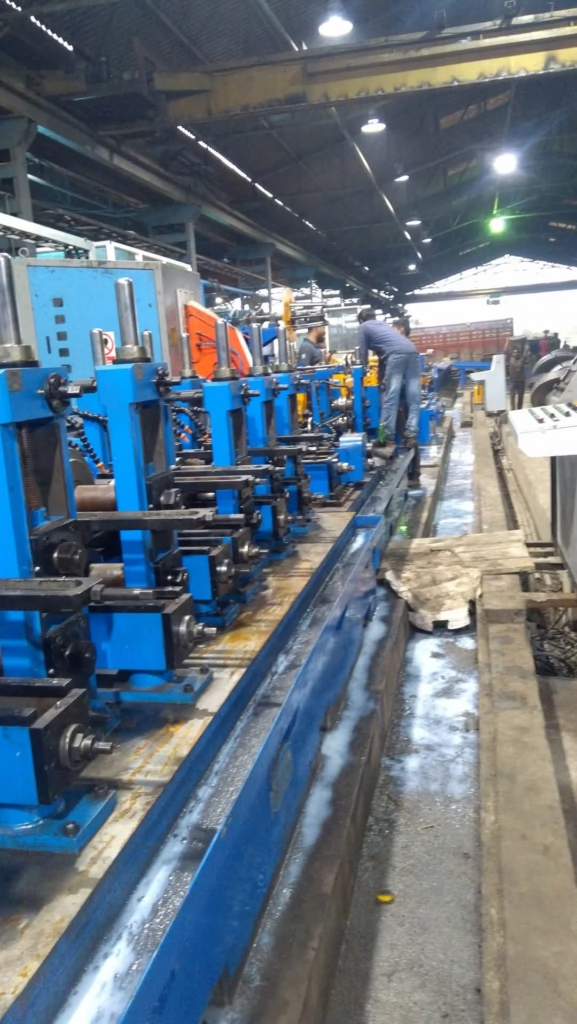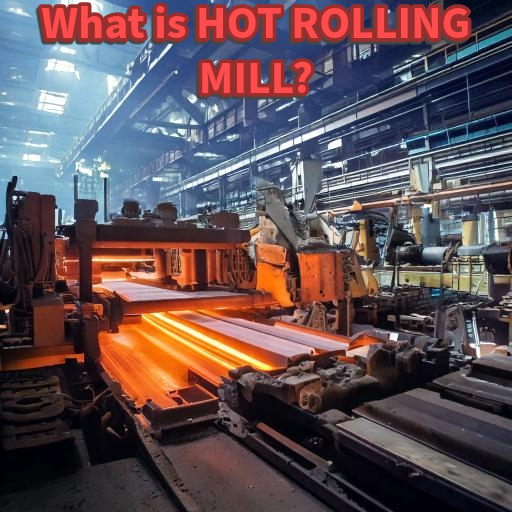An ERW (Electric Resistance Welded) tube mill is a type of machine that welds steel strips to form tubes and pipes. It is based on the principle of longitudinal seam welding; that is, the steel strip is rolled into a cylindrical shape and then welded by the application of high-frequency electric current. ERW tube mills are used in manufacturing round, square, and rectangular tubes that are extensively required in a variety of industrial and commercial applications.
The main components of an ERW tube mill include an uncoiler, strip leveling machine, forming section, welding unit, sizing section, and cut-off equipment. First, a steel strip is fed into it; then, the strip, after passing through a series of forming rolls, takes a cylindrical shape in the forming section. In the welding unit, high-frequency electric current welds the edges of that cylindrical shape together to obtain a strong, seamless joint. Finally, it is customized to the required dimensions and length in the sizing and cutting sections.
The ERW tube mill finds applications in the oil and gas pipeline industry, construction, scaffolding, and manufacture of furniture, and automotive industries. This machine has a high efficiency and precision level in mass production. To have better speed and quality, the advanced ERW mills are also equipped with the latest automation and energy-saving technologies.
While an ERW tube mill requires skilled labor and periodic maintenance, it is flexible and economical to run; hence, serving ideally for industrial applications, this machine is of key importance in the manufacture of high-quality tubes and pipes that meet modern manufacturing needs.
Components and Features of ERW Tube Mill
Uncoiler: The first section of the ERW tube mill is an uncoiler, which holds the steel coil and feeds it into the line. It unwinds the strip of steel and then feeds it for processing. The modern uncoiler is also equipped with a hydraulic system, easy to handle heavy coils. The tension control adjustment ensures smooth unwinding of the strip, which improves production efficiency and product quality.
Strip Leveling Machine: The strip leveling machine removes bends and irregularities from the coil. This makes the steel strip perfectly flat and uniform, which is very important for the proper formation of the tube. Leveling rollers and precision adjustment features guarantee high accuracy and consistency. The quality of the strip is also easy to inspect at this stage, allowing for early detection of defects.
Forming Section: The forming section is the first and primary stage of tube forming. In this stage, a steel strip, through gradual rolls in a tubular shape, is formed into a tubular shape. The forming rollers and stands of high precision ensure the correctness of dimension and alignment of the tube. This section works on many rollers, which shape the strip without distortion and uniformly. Different sizes and shapes of tubes—round, square, rectangular—can be easily formed with an adjustable forming mechanism.
Welding Unit: The welding unit is the heart of the ERW tube mill. It uses high-frequency welding technology that joins the edges of the steel strip effectively. The welding process is very fast and seamless, ensuring a strong and defect-free joint. Advanced welding units are equipped with real-time monitoring and heat control features, which maintain the quality of the weld at a constantly high level. There is also a post-welding cooling system, which reduces material distortion.
Sizing Section: The sizing section ensures that the tube finally has a set dimension and it is uniform. This is where, at this point, the diameter and thickness are adjusted to desire. The sizing of the tubes is done using precision rollers, and calibration instruments ensure the required accuracy of the tube. Surface finish and straightness are optimized in this section. Different specs of tubes could easily be done with adjustable settings, thus enhancing the versatility of the machine.
Cut-Off Equipment: The cut-off equipment is, in itself, used for cutting the tube to the required length. Modern cut-off units come equipped with high-speed flying saws and cold cutting techniques that ensure burr-free and precise cuts. Features such as automatic length adjustment and synchronization increase the productivity and efficiency. The system is very fast and provides continuous cutting without hampering the process of production; hence, downtime is reduced to a great extent.
Control System: The control system of the ERW tube mill has overall supervision in the monitoring and regulating process. Advanced control panels with automation technology offer online real-time monitoring at each step of production. The sensors and feedback loops readjust parameters of machines in operation continuously, to maintain quality consistency and reduce wastage. HMI and PLC systems make operation friendly and efficient. Safety features such as emergency stops and alarms provide reliability for both the machine and the operator.

Production Process of ERW Tube Mill
Raw Material Preparation
The process of manufacturing an ERW (Electric Resistance Welded) tube mill starts from the raw material. In this, either steel coils or strips are used, and accordingly, their grade and thickness are selected. First of all, the steel coils are passed through an uncoiler machine where the coil gets unwound. Thereafter, the strip is passed through a leveling machine where its flatness and uniformity are ensured. This stage is principally intended to ensure that the steel strip is free from tension and such defects as warping or uneven edges are completely removed. The quality of the raw material used is very important since the strength and durability of the final tube will directly relate to it.
Forming Section
The steel strip is rolled into a circular or desired shape in the forming section. The rolls gradually form the strip of steel into shape in a progressive manner, without cracking or uneven deformation. In the forming section, the alignment and pressure must be very precise to make the shape accurate. The forming is done by machines, which are automated and hence highly accurate and consistent. This is an important step because this will determine the geometry in which the tube shall finally be.

Welding Section
The formed tube is passed on to the welding section, where its longitudinal seam is welded. The ERW process uses high-frequency electric current, which melts the edges of the metal and welds them. This welding provides a seamless and strong joint. After welding, the extra material (bead) is removed by trimming tools so that the surface of the tube is smooth and defect-free. This stage also includes a very crucial step, the checking of integrity and strength of the weld by which high-quality tubes can only be made.
Sizing and Shaping Section
From here, it proceeds to the sizing section, where the final diameter and thickness of the tube are set. Sizing rolls are used in achieving the exact dimensions desired as required by the tubing specs. It guarantees that all dimensions of the tubes are equal and apt for final application in their use. This includes round, square, and rectangular. When sizing, the strength and uniformity are in consideration with respect to the tube.
Cutting and Finishing
It requires an approximate size to be attained by means of a flying saw or automated cutting machine after sizing; hence, this does not interfere with production. After being cut, the tubes are further moved to the finishing station, where surface finishing, deburring, and quality inspection take place. Finished tubes will undergo a number of quality checks by visual and dimensional inspections. Following inspection, it is moved into bundling and packaging.
Applications of ERW Tube Mill
Construction Industry:
ERW tubes are in wide application within the construction industry, which has huge demand for steel tubes and pipes. In construction, ERW tubes serve primarily as support and scaffolding structures and in load-supporting elements. Strong, durable, yet lightweight, these tubes can be trusted in projects such as buildings and bridges. ERW pipes are effective and economical for columns, beams, and roofing structures. They have resistance toward corrosion with accurate dimensions in construction projects, which improves their quality and life span.
Automotive Industry:
ERW tubes find their way into the automobile industry for applications in the manufacture of vehicle exhaust systems, chassis, and roll cages. With their smooth surface finish and even wall thickness, ERW tubes become just the perfect candidates for the manufacture of precision components. The use of ERW tube mills results in high-strength yet lightweight tubes, giving better performance and fuel efficiency to vehicles. Most importantly, such tubes can be designed to exact dimensions and shapes during production; this is of fundamental necessity for every form of automotive design.
Oil and Gas Industry:
ERW tubes are in high demand in the oil and gas pipelines. They can bear high-pressure and high-temperature conditions. ERW tubes are a sound solution to ensure that crude oil and natural gas are moved effectively. Their corrosive resistive nature and leak-proof provides strength to the pipes and hence, they last longer. They have wide-scale usage in offsite and onsite facilities.
Furniture Manufacturing:
ERW tubes are used in the furniture industry for the manufacture of light-weight and aesthetic furniture. They are most commonly found in the frames of chairs, tables, beds, and cabinets. High-quality finishing on the inside surface of the ERW tubes provides excellent furniture design. They are also inexpensive and easy to work with, hence reducing production costs while providing tailorable solutions.
HVAC Systems:
ERW tubes are in great demand in HVAC systems. They are the most essential ducts for air and cooling systems. The ERW tube mills produce thin-walled and light-weight tubes to assure smooth flow and effective heat exchange. The tubes are quite common in HVAC systems, assuring strength, corrosion resistance, and smooth flow, thereby enhancing efficiency and life expectancy.
Agriculture Equipment:
ERW tubes are also used in agricultural machinery and irrigation systems. These strong and durable tubes are applied in farm equipment like plows, tractors, and harvesters. ERW tubes are also a very reliable and cost-effective solution for constructing pipelines for irrigation.
Challenges and Maintenance of ERW Tube Mill
Challenges in ERW Tube Mill Operations: ERW tube mill operations face a lot of technical challenges that directly impact production efficiency and output quality. The biggest challenge is the maintenance of accuracy in the welding process. If welding alignment is not proper, it can create weak weld joints and defects. Material handling is also a major issue where alignment and tension control of steel strips are critical. Besides, quality variation of raw material can also cause problems in uniform tube production. High-frequency welding poses the risk of overheating, which can cause weld cracks and distortions. Further, wear and tear is also higher due to high-speed production, which increases downtime. Lack of skilled labor and absence of proper training also hinder efficient operations.
Maintenance of ERW Tube Mill: ERW tube mill requires regular maintenance for smooth and efficient operation. A good lubrication system must be ensured to reduce friction and wear of components such as rollers, bearings, and shafts. The welding electrodes and cutting blades should also be checked and replaced in a timely manner to avoid poor weld quality and inexact tube lengths. Correct positioning of rollers and welding heads must be checked using alignment tools and gauges. Regular cleaning and removal of debris will enhance the life span of the machine. There should be a preventive maintenance schedule in place, which will reduce the occurrence of unexpected breakdowns and downtime. The high-frequency welding units should be calibrated, and cooling systems should be monitored to prevent overheating and failure of equipment. Skilled technicians are to be employed who can understand the intricate mechanisms of the machine and effect timely repairs. Advanced monitoring systems and automation make maintenance processes more efficient.
Technological Advancements of ERW Tube Mill
High-Frequency Welding Technology:
Important in the development of ERW tube mill machines, high-frequency welding technology has significantly improved efficiency and weld quality. It makes use of a high-frequency electrical current that quickly heats the edges of the steel strip before the joining process begins. HF welding basically makes the tube joints seamless and defect-free; hence, giving them more strength and durability for high-speed production to satisfy large industries.
Automation and Control Systems:
The major modernization aspects of ERW tube mills lie in the level of automation and incorporation with advanced control systems. This allows real-time monitoring and changes in the machines through automatic controls, aided by programmable logic controllers (PLC) and human-machine interfaces (HMI). This enhances production accuracy and consistency. Automation in the material handling and tube-forming process reduces manual errors and downtime. The development reduces operational costs and improves productivity.
Real-Time Quality Monitoring Systems:
The new generation of ERW tube mills is equipped with real-time quality monitoring systems, which inspect weld quality and tube dimensions at every stage of production. Advanced sensors and cameras detect defects and suggest corrective actions. This technology significantly reduces production losses and rejections.
Energy-Efficient Solutions:
The most important advantage of ERW tube mills is that they are energy-efficient. They have high-efficiency motors and advanced cooling systems, which make them consume lesser power. They are not only cost-effective but also make the industry eco-friendly to achieve sustainability goals.
Customization and Versatility:
Modern ERW tube mills have technologically advanced and become more versatile, allowing ease of producing tubes in different sizes and shapes, round, square, or rectangular. Moreover, compatibility with a variety of materials, such as mild steel, stainless steel, and alloys, guarantees meeting the requirements of each industry.
Conclusion of ERW Tube Mill
The ERW tube mill is quite advanced and efficient technology in the production of high-quality tubes and pipes. The versatility and precision of this machine make it a very essential tool for any industrial manufacturing. It is mostly used in the manufacture of tubes and pipes from mild steel, stainless steel, and alloy materials, which can be custom-made into various shapes such as round, square, and rectangular. The ERW tube mill uses high-frequency welding for the strength and durability of the welds in the tubes and also gives a seamless appearance.
This machine gives an effective and economical way of producing on a large scale with uniform dimensions and a smooth surface finish. Common applications include construction, automotive, oil and gas, scaffolding, and HVAC. New technologies developed—such as automation and real-time monitoring systems—have given way to better productivity and efficiency of the ERW tube mill.
However, this type of ERW tube mill also has disadvantages such as skilled operators and periodical maintenance. Defects in production and material wastage must be kept to a minimum with constant control ensuring proper alignment and welding quality.
In general, the ERW tube mill has been designed as a modern and reliable means of obtaining high-performance and durable tubes to be used for industrial purposes. Its flexibility, precision, and cost efficiency surely make it one of the important parts of manufacturing industries. Its role is gaining importance with a change in the demands of the industry due to technological upgrades. Surely, it is a promising and sustainable option for manufacturing in the future.



